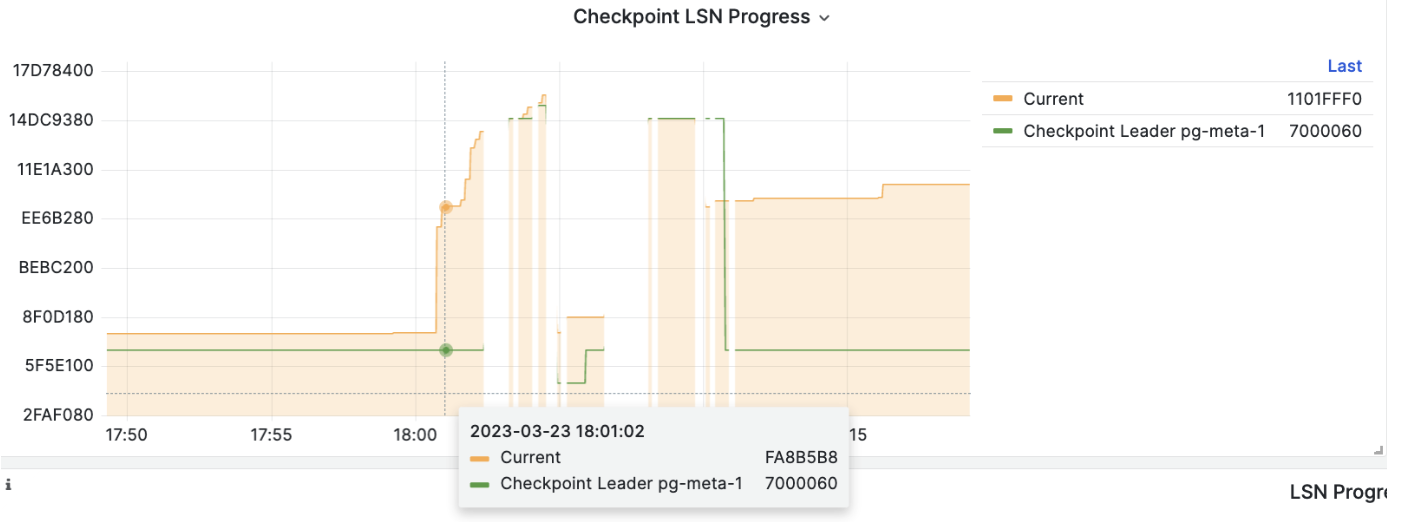时间点恢复
您可以将集群恢复回滚至过去任意时刻,避免软件缺陷与人为失误导致的数据损失。
Pigsty 的 PostgreSQL 集群带有自动配置的时间点恢复(PITR)方案,基于备份组件 pgBackRest 与可选的对象存储仓库 MinIO 提供。
高可用方案 可以解决硬件故障,但却对软件缺陷与人为失误导致的数据删除/覆盖写入/删库等问题却无能为力。 对于这种情况,Pigsty 提供了开箱即用的 时间点恢复(Point in Time Recovery, PITR)能力,无需额外配置即默认启用。
Pigsty 为您提供了基础备份与 WAL 归档的默认配置,您可以使用本地目录与磁盘,亦或专用的 MinIO 集群或 S3 对象存储服务来存储备份并实现异地容灾。 当您使用本地磁盘时,默认保留恢复至过去一天内的任意时间点的能力。当您使用 MinIO 或 S3 时,默认保留恢复至过去一周内的任意时间点的能力。 只要存储空间管够,您尽可保留任意长地可恢复时间段,丰俭由人。
时间点恢复(PITR)解决什么问题?
- 容灾能⼒增强:RPO 从 ∞ 降⾄ ⼗⼏MB, RTO 从 ∞ 降⾄ ⼏⼩时/⼏刻钟。
- 确保数据安全:C/I/A 中的 数据完整性:避免误删导致的数据⼀致性问题。
- 确保数据安全:C/I/A 中的 数据可⽤性:提供对“永久不可⽤”这种灾难情况的兜底
| 单实例配置策略 | 事件 | RTO | RPO |
|---|---|---|---|
| 什么也不做 | 宕机 | 永久丢失 | 全部丢失 |
| 基础备份 | 宕机 | 取决于备份大小与带宽(几小时) | 丢失上一次备份后的数据(几个小时到几天) |
| 基础备份 + WAL归档 | 宕机 | 取决于备份大小与带宽(几小时) | 丢失最后尚未归档的数据(几十MB) |
时间点恢复有什么代价?
- 降低数据安全中的 C:机密性,产生额外泄漏点,需要额外对备份进⾏保护。
- 额外的资源消耗:本地存储或⽹络流量 / 带宽开销,通常并不是⼀个问题。
- 复杂度代价升⾼:⽤户需要付出备份管理成本。
时间点恢复的局限性
如果只有 PITR 用于故障恢复,则 RTO 与 RPO 指标相比 高可用方案 更为逊色,通常应两者组合使用。
- RTO:如果只有单机 + PITR,恢复时长取决于备份大小与网络/磁盘带宽,从十几分钟到几小时,几天不等。
- RPO:如果只有单机 + PITR,宕机时可能丢失少量数据,一个或几个 WAL 日志段文件可能尚未归档,损失 16 MB 到⼏⼗ MB 不等的数据。
除了 PITR 之外,您还可以在 Pigsty 中使用 延迟集群 来解决人为失误或软件缺陷导致的数据误删误改问题。
原理
时间点恢复允许您将集群恢复回滚至过去的“任意时刻”,避免软件缺陷与人为失误导致的数据损失。要做到这一点,首先需要做好两样准备工作:基础备份 与 WAL归档。 拥有 基础备份,允许用户将数据库恢复至备份时的状态,而同时拥有从某个基础备份开始的 WAL归档,允许用户将数据库恢复至基础备份时刻之后的任意时间点。
详细原理,请参阅:基础备份与时间点恢复;具体操作,请参考 PGSQL管理:备份恢复。
基础备份
Pigsty 使用 pgbackrest 管理 PostgreSQL 备份。pgBackRest 将在所有集群实例上初始化空仓库,但只会在集群主库上实际使用仓库。
pgBackRest 支持三种备份模式:全量备份,增量备份,差异备份,其中前两者最为常用。 全量备份将对数据库集群取一个当前时刻的全量物理快照,增量备份会记录当前数据库集群与上一次全量备份之间的差异。
Pigsty 为备份提供了封装命令:/pg/bin/pg-backup [full|incr]。您可以通过 Crontab 或任何其他任务调度系统,按需定期制作基础备份。
WAL归档
Pigsty 默认在集群主库上启⽤了 WAL 归档,并使⽤ pgbackrest 命令行工具持续推送 WAL 段⽂件至备份仓库。
pgBackRest 会⾃动管理所需的 WAL ⽂件,并根据备份的保留策略及时清理过期的备份,与其对应的 WAL 归档⽂件。
如果您不需要 PITR 功能,可以通过 配置集群: archive_mode: off 来关闭 WAL 归档,移除 node_crontab 来停止定期备份任务。
实现
默认情况下,Pigsty提供了两种预置备份策略:默认使用本地文件系统备份仓库,在这种情况下每天进行一次全量备份,确保用户任何时候都能回滚至一天内的任意时间点。备选策略使用专用的 MinIO 集群或S3存储备份,每周一全备,每天一增备,默认保留两周的备份与WAL归档。
Pigsty 使用 pgBackRest 管理备份,接收 WAL 归档,执行 PITR。备份仓库可以进行灵活配置(pgbackrest_repo):默认使用主库本地文件系统(local),但也可以使用其他磁盘路径,或使用自带的可选 MinIO 服务(minio)与云上 S3 服务。
pgbackrest_enabled: true # 在 pgsql 主机上启用 pgBackRest 吗?
pgbackrest_clean: true # 初始化时删除 pg 备份数据?
pgbackrest_log_dir: /pg/log/pgbackrest # pgbackrest 日志目录,默认为 `/pg/log/pgbackrest`
pgbackrest_method: local # pgbackrest 仓库方法:local, minio, [用户定义...]
pgbackrest_repo: # pgbackrest 仓库:https://pgbackrest.org/configuration.html#section-repository
local: # 默认使用本地 posix 文件系统的 pgbackrest 仓库
path: /pg/backup # 本地备份目录,默认为 `/pg/backup`
retention_full_type: count # 按计数保留完整备份
retention_full: 2 # 使用本地文件系统仓库时,最多保留 3 个完整备份,至少保留 2 个
minio: # pgbackrest 的可选 minio 仓库
type: s3 # minio 是与 s3 兼容的,所以使用 s3
s3_endpoint: sss.pigsty # minio 端点域名,默认为 `sss.pigsty`
s3_region: us-east-1 # minio 区域,默认为 us-east-1,对 minio 无效
s3_bucket: pgsql # minio 桶名称,默认为 `pgsql`
s3_key: pgbackrest # pgbackrest 的 minio 用户访问密钥
s3_key_secret: S3User.Backup # pgbackrest 的 minio 用户秘密密钥
s3_uri_style: path # 对 minio 使用路径风格的 uri,而不是主机风格
path: /pgbackrest # minio 备份路径,默认为 `/pgbackrest`
storage_port: 9000 # minio 端口,默认为 9000
storage_ca_file: /etc/pki/ca.crt # minio ca 文件路径,默认为 `/etc/pki/ca.crt`
bundle: y # 将小文件打包成一个文件
cipher_type: aes-256-cbc # 为远程备份仓库启用 AES 加密
cipher_pass: pgBackRest # AES 加密密码,默认为 'pgBackRest'
retention_full_type: time # 在 minio 仓库上按时间保留完整备份
retention_full: 14 # 保留过去 14 天的完整备份
# 您还可以添加其他的可选备份仓库,例如 S3,用于异地容灾
Pigsty 参数 pgbackrest_repo 中的目标仓库会被转换为 /etc/pgbackrest/pgbackrest.conf 配置文件中的仓库定义。
例如,如果您定义了一个美西区的 S3 仓库用于存储冷备份,可以使用下面的参考配置。
s3: # ------> /etc/pgbackrest/pgbackrest.conf
repo1-type: s3 # ----> repo1-type=s3
repo1-s3-region: us-west-1 # ----> repo1-s3-region=us-west-1
repo1-s3-endpoint: s3-us-west-1.amazonaws.com # ----> repo1-s3-endpoint=s3-us-west-1.amazonaws.com
repo1-s3-key: '<your_access_key>' # ----> repo1-s3-key=<your_access_key>
repo1-s3-key-secret: '<your_secret_key>' # ----> repo1-s3-key-secret=<your_secret_key>
repo1-s3-bucket: pgsql # ----> repo1-s3-bucket=pgsql
repo1-s3-uri-style: host # ----> repo1-s3-uri-style=host
repo1-path: /pgbackrest # ----> repo1-path=/pgbackrest
repo1-bundle: y # ----> repo1-bundle=y
repo1-cipher-type: aes-256-cbc # ----> repo1-cipher-type=aes-256-cbc
repo1-cipher-pass: pgBackRest # ----> repo1-cipher-pass=pgBackRest
repo1-retention-full-type: time # ----> repo1-retention-full-type=time
repo1-retention-full: 90 # ----> repo1-retention-full=90
恢复
您可以直接使用以下封装命令可以用于 PostgreSQL 数据库集群的 时间点恢复。
Pigsty 默认使用增量差分并行恢复,允许您以最快速度恢复到指定时间点。
pg-pitr # 恢复到WAL存档流的结束位置(例如在整个数据中心故障的情况下使用)
pg-pitr -i # 恢复到最近备份完成的时间(不常用)
pg-pitr --time="2022-12-30 14:44:44+08" # 恢复到指定的时间点(在删除数据库或表的情况下使用)
pg-pitr --name="my-restore-point" # 恢复到使用 pg_create_restore_point 创建的命名恢复点
pg-pitr --lsn="0/7C82CB8" -X # 在LSN之前立即恢复
pg-pitr --xid="1234567" -X -P # 在指定的事务ID之前立即恢复,然后将集群直接提升为主库
pg-pitr --backup=latest # 恢复到最新的备份集
pg-pitr --backup=20221108-105325 # 恢复到特定备份集,备份集可以使用 pgbackrest info 列出
pg-pitr # pgbackrest --stanza=pg-meta restore
pg-pitr -i # pgbackrest --stanza=pg-meta --type=immediate restore
pg-pitr -t "2022-12-30 14:44:44+08" # pgbackrest --stanza=pg-meta --type=time --target="2022-12-30 14:44:44+08" restore
pg-pitr -n "my-restore-point" # pgbackrest --stanza=pg-meta --type=name --target=my-restore-point restore
pg-pitr -b 20221108-105325F # pgbackrest --stanza=pg-meta --type=name --set=20221230-120101F restore
pg-pitr -l "0/7C82CB8" -X # pgbackrest --stanza=pg-meta --type=lsn --target="0/7C82CB8" --target-exclusive restore
pg-pitr -x 1234567 -X -P # pgbackrest --stanza=pg-meta --type=xid --target="0/7C82CB8" --target-exclusive --target-action=promote restore
在执行 PITR 时,您可以使用 Pigsty 监控系统观察集群 LSN 位点状态,判断是否成功恢复到指定的时间点,事务点,LSN位点,或其他点位。
